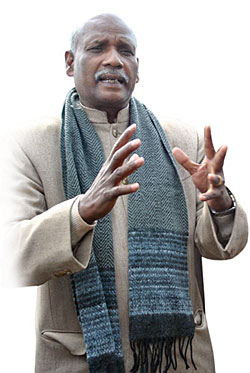 |
As yet another Madhesi party bites the dust and is reduced to almost half its size at the parliamentary party level, the question that has dogged the politics of the plains is back. Why is there such fragmentation among Madhesi outfits?
Take the latest case of Mahendra Yadav, who walked away from TMDP. Yadav recognised in 2007 that the future of Madhesi leaders in UML was bleak. Those who wanted a counter to Upendra Yadav were on the lookout for Yadav leaders who could undercut Upendra's caste base, and saw Mahendra as a potential foil. Obviously, Upendra's stature was much bigger, but Mahendra found an honourable space in TMDP. His presence helped convey that the party was not merely a club of upper caste leaders.
Though Mahendra Yadav played a role in start-up operations, his disenchantment began soon after. As Mahant Thakur increasingly relied on Hridayesh Tripathi, Sarvendra Nath Shukla, Brikesh Chandra Lal and others for the day-to-day functioning of TMDP, Yadav began a whisper campaign about how the party had been 'hijacked'. After the fall of the Maoist-led government, Yadav campaigned to get TMDP to join the government � even though the other senior leaders were averse to the idea as they knew it would destroy the party's credibility. India too wanted TMDP to join the anti-Maoist government to lend it more stability, and used Yadav to indirectly influence party equations. Yadav ended up with a lucrative ministerial portfolio.
Despite being accommodated, Yadav was openly critical of the party leadership. He developed his own coterie among non-upper caste MPs, largely Yadavs, intermediate castes, and some Tharus and Muslims.
The immediate trigger for the split appears to be the prospect that the next house session could throw up a new PM. The old UML connections have worked. Jhalanath Khanal is aware that a UML-Maoist government, even if it wins the vote, will find it impossible to function: NC will stay in the opposition, and Madhesi parties could well begin agitational politics. He is ensuring that he has a broader support base, and is offering incentives to leaders from different Madhesi parties to support his imminent prime ministerial bid. It works for Yadav too, as he gets to head his own party, retains his portfolio as long as the caretaker government lasts, and will probably get something even more profitable in the next alliance with his increased bargaining power.
The details are important for they offer us a glimpse into an underlying pattern at work in Madhesi politics.
Nepali parties are centred on individuals. But in bigger parties, the organisational banner and symbol are critical; the stakes are higher; and it is far more difficult to trigger a vertical organisational split. In small, nascent outfits, it is largely personal connections, patronage, and resources that enable a politician to climb up. He makes money, and distributes it to loyalists � and that spurs his leadership ambitions even more. It is far more challenging to work for years to build the party when he can use his limited social base to fetch immediate rewards in the fragmented Kathmandu polity.
Look at Rajendra Mahato. He is happy with his small party instead of working for a broader Sadbhavana platform � he has money, commands nine MPs (a number that will soon shrink), and has been a minister in all governments since 2006. Expanding will only increase the pressure on him to share the spoils. Mahendra Yadav will follow a similar trajectory.
Add to this the fact that many of these parties are top-heavy. For example, TMDP was formed after already established leaders came together, not through a natural bottom-up party formation process where activists slowly rise up through multiple levels. Managing egos in such set-ups, where the hierarchy is unclear and often under challenge, is difficult for the supreme leader. In a fascinating article in Kantipur this week, Madhesi leader JP Gupta documented all the splits that have taken place in Madhesi parties since the 1950s, and found the stated reason for most divisions is disenchantment of senior and mid-level leaders with the party president/chairman's working style.
Caste, ethnicity, ideology, the differing political backgrounds of the leaders, conflicts over resource-sharing, India's role and willingness to create and split Madhesi parties according to shifting priorities: all have played a crucial role in the fragmentation of Tarai politics. But at its root, the divisions are driven by the individual leader's calculation that the benefits of forming a splinter outfit � by way of a portfolio, a party position, increased prestige, autonomy, or just more money � outweigh the risks of finding one's own way in a challenging political landscape and being tainted as a regular defector. The churning will continue: expect newer Madhesi parties soon.
READ ALSO:
Stop wasting time, EDITORIAL
Post-UNMIN tasks, DAMAKANT JAYSHI



